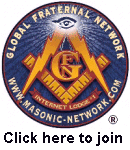
The GFN Treasure Chest Archives
www.masonic-network.com
"Where Master Masons Communicate"

 |
The GFN Treasure Chest Archiveswww.masonic-network.com |
 |
"RITUAL. The mode of opening and closing Lodge, of conferring the Degrees, of installation and other duties, constitute a System of ceremonies which are called the Ritual. Much of this Ritual is esoteric, and, not being permitted to be committed to writing, is communicated only by oral instruction. In each Masonic Jurisdiction it is required, by the superintending authority, that the ritual shall be the same; but it more or less differs in the different Rites and Jurisdictions. But this does not affect the universality of Freemasonry.
The Ritual is only the external and extrinsic form. The doctrine of Freemasonry is everywhere the same. It is the Body which is unchangeable -- remaining always and everywhere the same. The Ritual is but the outer garment which covers this Body, which is subject to continual variation. It is right and desirable that the Ritual should be made perfect, and everywhere alike. But if this be impossible, as it is, this at least will console us, that while the ceremonies, or Ritual, have varied at different periods, and still vary in different countries, the science and philosophy, the symbolism and the religion, of Freemasonry continue, and will continue to be the same wherever true Freemasonry is practiced."
Christopher Hodapp, Freemasons for Dummies:
"The ceremonies Freemasons practice in their lodges are referred to as rituals. Rituals aren't peculiar to Freemasonry -- they occur all around us in everyday life. . . . Rituals reinforce spiritual or social bonds through repetition and widespread use. Rituals transmit common experiences across time and connect modern society with the past. . . .
Rituals of initiation, like weddings or baptisms, have an especially powerful effect on people. They imply the beginning of a physical or spiritual journey, as well as the promise of learning secrets that have been kept from us.
In Ancient Craft Freemasonry, the variety of Masonry conducted in your local Masonic lodge, these rituals are called degrees, and they progress from the Entered Apprentice, to the Fellow Craft, and finally to the Master Mason. The degrees connect Freemasons down through the centuries, and knowing you're going through the same experience that millions of other men around the world have gone through for hundreds of years is an awesome feeling."
John Rossner, The Primordial Tradition:
"There is a curious belief which seems to have been fairly well disseminated throughout ancient Semitic and Graeco-Roman cultures that worshippers forming an ethnic and/or cultic community could be united both together and to a common god, lord, hero or other object of worship by means of a dramatic ceremony or ritual in which all participated.
The ancient 'mystery rite' consisted first of a cultic 'anamnensis,' or memorial, in which it was thought that a particularly important or salvation-bearing act, which was once performed by the god or hero, was psychically present for the benefit of the worshippers. The god or hero might be either a historical, a legendary, or a purely mythical figure, but s/he embodied for them a primordial or supernatural being with which worshippers were enabled to share his/her actions, and hence, in his /her life."
W.L. Wilmshurst, The Meaning of Masonry:
"To trace the genesis of the movement, which came into activity some 250 years ago (our rituals having been compiled round about the year 1700), is beyond the purpose of my present remarks. It may merely be stated that the movement itself incorporated the slender ritual and the elementary symbolism that, for centuries previously, had been employed in connection with the mediaeval Building Guilds, but it gave them a far fuller meaning and a far wider scope.
. . . All that I wish to emphasize at this stage is that our present system is not one coming from remote antiquity; that there is no direct continuity between us and the Egyptians, or even those ancient Hebrews who built, in the reign of King Solomon, a certain Temple at Jerusalem. What is extremely ancient in Freemasonry is the spiritual doctrine concealed within the architectural phraseology; for this doctrine is an elementary form of the doctrine that has been taught in all ages, no matter in what garb it has been expressed. . . .
You must not imply from this that modern Masonry is by any means a full or adequate presentation of these older and larger systems. It is but their pale and elementary shadow. But such as they are, and so far as they do go, our rituals and doctrine are an authentic embodiment of a secret doctrine and a secret process that have always existed for the enlightenment of such aspirants as, putting their trust in God (as our present candidates are made to say), have knocked at the door of certain secret sanctuaries in the confidence that that door would open and that they would find in due course that for which they were seeking. Those who instituted modern speculative Masonry some 250 years ago took certain materials lying ready to hand. They took, that is, the elementary rites and symbols pertaining to mediaeval operative guilds of stone-masons and transformed them into a system of religio-philosophic doctrine. Thenceforward, from being related to the trade which deals in stones and bricks, the intention of Masonry was to deal solely and simply with the greater science of soul-building; and, save for retaining certain analogies which the art of the practical stone-mason provided, thenceforward it became dedicated to purposes that are wholly spiritual, religious and philosophic."